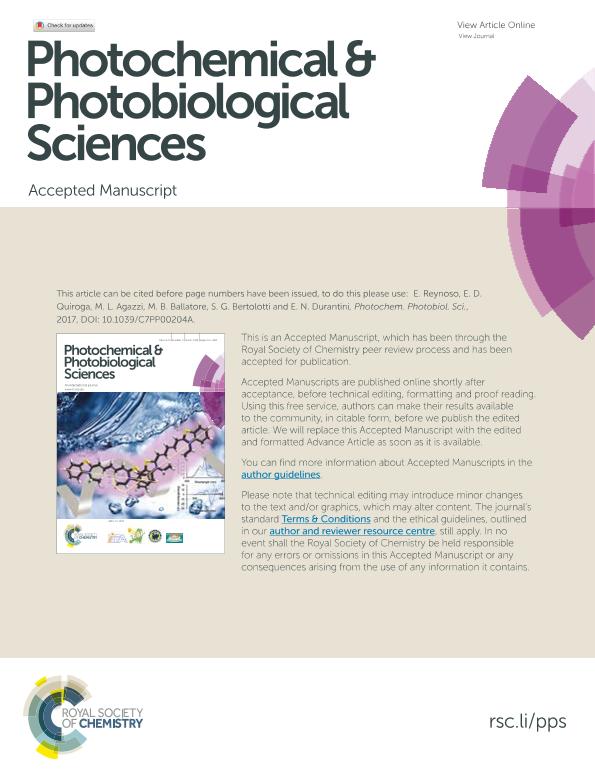Artículo
Photodynamic inactivation of microorganisms sensitized by cationic BODIPY derivatives potentiated by potassium iodide
Reynoso, Eugenia ; Quiroga, Ezequiel Dario
; Quiroga, Ezequiel Dario ; Agazzi, Maximiliano Luis
; Agazzi, Maximiliano Luis ; Ballatore, María Belén
; Ballatore, María Belén ; Bertolotti, Sonia Graciela
; Bertolotti, Sonia Graciela ; Durantini, Edgardo Néstor
; Durantini, Edgardo Néstor
 ; Quiroga, Ezequiel Dario
; Quiroga, Ezequiel Dario ; Agazzi, Maximiliano Luis
; Agazzi, Maximiliano Luis ; Ballatore, María Belén
; Ballatore, María Belén ; Bertolotti, Sonia Graciela
; Bertolotti, Sonia Graciela ; Durantini, Edgardo Néstor
; Durantini, Edgardo Néstor
Fecha de publicación:
08/2017
Editorial:
Royal Society of Chemistry
Revista:
Photochemical and Photobiological Sciences
ISSN:
1474-905X
e-ISSN:
1474-9092
Idioma:
Inglés
Tipo de recurso:
Artículo publicado
Clasificación temática:
Resumen
The photodynamic inactivation mediated by 1,3,5,7-tetramethyl-8-[4-(N,N,N-trimethylamino)phenyl]-4,4-difluoro-4-bora-3a,4a-diaza-s-indacene 3 and 8-[4-(3-(N,N,N-trimethylamino)propoxy)phenyl]-4,4-difluoro-4-bora-3a,4a-diaza-s-indacene 4 was investigated on Staphylococcus aureus, Escherichia coli and Candida albicans. In vitro experiments indicated that BODIPYs 3 and 4 were rapidly bound to microbial cells at short incubation periods. Also, fluorescence microscopy images showed green emission of BODIPYs bound to microbial cells. Photosensitized inactivation improved with an increase of the irradiation time. Similar photoinactivation activities were found for both BODIPYs in bacteria. The photoinactivation induced by these BODIPYs was effective for both bacteria. However, the Gram-positive bacterium was inactivated sooner and with a lower concentration of a photosensitizer than the Gram-negative bacterium. After 15 min irradiation, the complete eradication of S. aureus was obtained with 1 μM photosensitizer. A reduction of 4.5log in the E. coli viability was found when using 5 μM photosensitizer and 30 min irradiation. Also, the last conditions produced a decrease of 4.5log in C. albicans cells treated with BODIPY 3, while 4 was poorly effective. On the other hand, the effect of the addition of KI on photoinactivation at different irradiation periods and salt concentrations was investigated. A smaller effect was observed in S. aureus because the photosensitizers alone were already very effective. In E. coli, photokilling potentiation was mainly found at longer irradiation periods. Moreover, the photoinactivation of C. albicans mediated by these BODIPYs was increased in the presence of KI. In solution, an increase in the formation of the BODIPY triplet states was observed with the addition of the salt, due to the effect of external heavy atoms. The greater intersystem crossing together with the formation of reactive iodine species induced by BODIPYs may be contributing to enhance the inactivation of microorganisms. Therefore, these BODIPYs represent interesting photosensitizers to inactivate microorganisms. In particular, BODIPY 3 in combination with KI was highly effective as a broad spectrum antimicrobial photosensitizer.
Archivos asociados
Licencia
Identificadores
Colecciones
Articulos(CCT - CORDOBA)
Articulos de CTRO.CIENTIFICO TECNOL.CONICET - CORDOBA
Articulos de CTRO.CIENTIFICO TECNOL.CONICET - CORDOBA
Citación
Reynoso, Eugenia; Quiroga, Ezequiel Dario; Agazzi, Maximiliano Luis; Ballatore, María Belén; Bertolotti, Sonia Graciela; et al.; Photodynamic inactivation of microorganisms sensitized by cationic BODIPY derivatives potentiated by potassium iodide; Royal Society of Chemistry; Photochemical and Photobiological Sciences; 16; 10; 8-2017; 1524-1536
Compartir
Altmétricas



